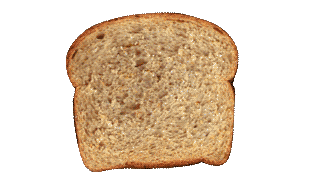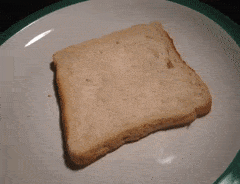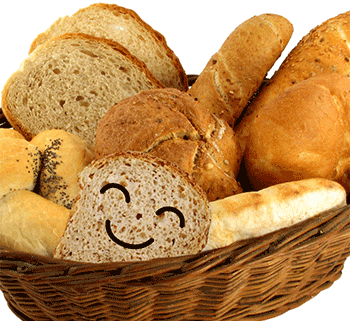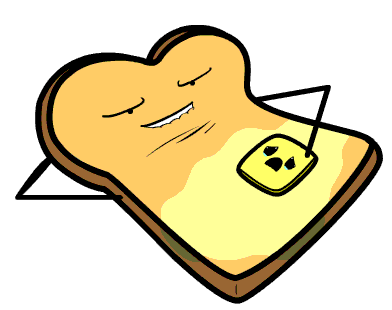Never Eat The ‘Clean’ Part
of Moldy Bread
Science Insider * Sep 12, 2018
of Moldy Bread
Science Insider * Sep 12, 2018

It’s not safe to eat bread or fruit contaminated with mold, even if you cut away the moldy parts. When mold reproduces, it spreads throughout your food, hiding in places you can't see. And while many species of mold are harmless, others can make you very sick. It's just not worth the risk.
🍞 🥖 🥐 🍞 🥖 🥐 🍞
Following is a transcript of the video:
Narrator: We've all been there. The loaf of bread you bought a couple weeks ago is starting to grow mold and you're wondering "Maybe I can just cut the part where I can see the mold and eat the clean part." It turns out, even though you cannot see it, your whole loaf of bread could be teaming with fungus. Following is a transcript of the video.
You're all ready to make the sandwich of your dreams. Turkey, tomato, and swiss on a bed of romaine lettuce sandwiched between two slices of sourdough. Classic.
Oh no, what's this? Mold? But look, good new. The mold's only on part of the bread. So, I can just cut that away and be fine, right?
 There's no such thing as a "clean" part of moldy bread. That's because mold is a fungus, like mushrooms. The caps on the surface are easy enough to spot. But there's a vast network of subterranean "roots" called hyphae that you can't see.
There's no such thing as a "clean" part of moldy bread. That's because mold is a fungus, like mushrooms. The caps on the surface are easy enough to spot. But there's a vast network of subterranean "roots" called hyphae that you can't see.
So let's take another look at that bread of yours. Ugh, disgusting!
Maybe you can just grab another piece from the same loaf. Well, that's not such a great idea, either. Because by the time mold sprouts its fuzzy head, what you're really seeing is the reproductive part of the mold called sporangiums. Each sporangium releases tens of thousands of spores.
So, even though you can't see it, that entire loaf could be teeming with fungus.
But it seems like such a waste to just throw it out. After all, you eat mold on purpose all the time, like the mold that goes into making cheese, soy sauce, and even life-saving antibiotics, like penicillin. Eating a little bit on your bread can't be that bad, right?
Ultimately, it's a gamble. Just like eating a wild mushroom, many are fine. But some can be deadly.
Mold is the same way. There are thousands of different species of mold — many of which are harmless to humans. But since so many types can sprout up on food it's nearly impossible to know if what you're eating is safe.
Cladosporium, for example, can sometimes trigger allergies but is generally harmless.
Narrator: We've all been there. The loaf of bread you bought a couple weeks ago is starting to grow mold and you're wondering "Maybe I can just cut the part where I can see the mold and eat the clean part." It turns out, even though you cannot see it, your whole loaf of bread could be teaming with fungus. Following is a transcript of the video.
You're all ready to make the sandwich of your dreams. Turkey, tomato, and swiss on a bed of romaine lettuce sandwiched between two slices of sourdough. Classic.
Oh no, what's this? Mold? But look, good new. The mold's only on part of the bread. So, I can just cut that away and be fine, right?

So let's take another look at that bread of yours. Ugh, disgusting!
Maybe you can just grab another piece from the same loaf. Well, that's not such a great idea, either. Because by the time mold sprouts its fuzzy head, what you're really seeing is the reproductive part of the mold called sporangiums. Each sporangium releases tens of thousands of spores.
So, even though you can't see it, that entire loaf could be teeming with fungus.
But it seems like such a waste to just throw it out. After all, you eat mold on purpose all the time, like the mold that goes into making cheese, soy sauce, and even life-saving antibiotics, like penicillin. Eating a little bit on your bread can't be that bad, right?
Ultimately, it's a gamble. Just like eating a wild mushroom, many are fine. But some can be deadly.
Mold is the same way. There are thousands of different species of mold — many of which are harmless to humans. But since so many types can sprout up on food it's nearly impossible to know if what you're eating is safe.
Cladosporium, for example, can sometimes trigger allergies but is generally harmless.
Whereas other molds, like Penicillium crustosum, produce harmful poisons called mycotoxins.
An elderly couple in 2005, for example, was admitted to the hospital after eating a can of soup contaminated with this kind of mold. They had severe muscle tremors but eventually recovered.
 But other molds, like Rhizopus stolonifer, can have permanent effects. And you might recognize this mold since it commonly grows on bread: blue-green, with black splotches, and super fuzzy. In rare cases, it can prompt a deadly infection called Zygomycosis, which causes your blood to clot and can, ultimately, starve your cells of oxygen to the point that they die.
But other molds, like Rhizopus stolonifer, can have permanent effects. And you might recognize this mold since it commonly grows on bread: blue-green, with black splotches, and super fuzzy. In rare cases, it can prompt a deadly infection called Zygomycosis, which causes your blood to clot and can, ultimately, starve your cells of oxygen to the point that they die.
 And it's not like bacteria where a little heat will eliminate the threat because high temperatures won't break down the mycotoxins.
And it's not like bacteria where a little heat will eliminate the threat because high temperatures won't break down the mycotoxins.


And since you have no clue which one you're about to put in your mouth, ask yourself: Is it really worth the risk?

Science Insider tells you all you need to know about science: space, medicine, biotech, physiology, and more.
- Subscribe to our channel and visit us at: http://www.businessinsider.com/science
- .Science Insider on Facebook: https://www.facebook.com/BusinessInsi...


No comments:
Post a Comment